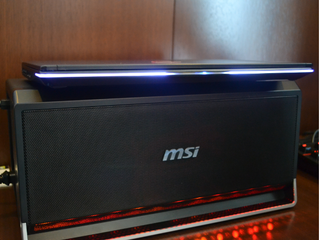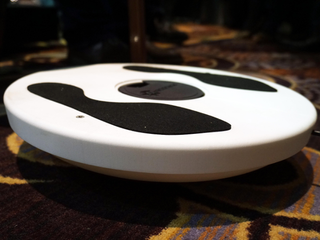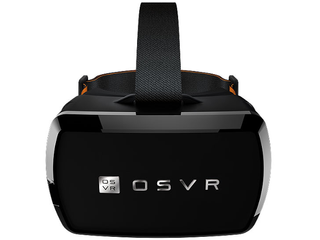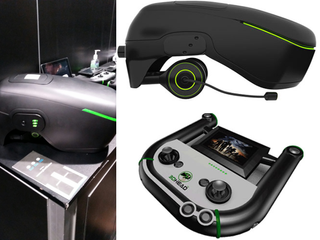Tom's Hardware's CES 2015 Top Picks
Best Mobile Technology

Nvidia Tegra X1
Nvidia's Tegra K1 SoC won our award for best mobile platform when it was announced last year at CES 2014. Its Kepler-based GPU brought a desktop-caliber architecture to mobile (well, tablets at least), and even a year later, it remains at or near the top of most graphics benchmark charts.
For CES 2015, Nvidia followed up the K1's dominating performance with the announcement of a successor, the Tegra X1. Based on the next-generation Maxwell architecture, the X1 employs 256 improved CUDA cores, offering a significant boost in graphics performance. The CPU also gets an upgrade, replacing the four 32-bit Cortex-A15 cores and single companion A15 core with four A57 cores and four A53 cores in an all 64-bit big.LITTLE configuration.
While Nvidia's new X1 should offer similar CPU performance to Snapdragon 810, its Maxwell GPU sets a new standard in graphics and compute performance that may not be exceeded until next year's CES.
Best Networking Technology

D-Link AC5300 Tri-Band Router
D-Link announced the Ultra series, a new line of performance-class 802.11ac routers. Among these is the D-Link AC5300 Ultra Wi-Fi router, a standout piece of equipment powered by a 1.4GHz processor. It first caught our attention with its striking good looks, but it also has a couple of features that helped it earn our Best Networking Technology award.
One of its primary features is MU-MIMO, a feature we’ve begun to see in several of the second wave of 802.11ac products. We also liked the AC5300’s performance rating. As a tri-band router, it spread its connective workload between three separate bands. In the case of the AC5300, D-Link splits the bands up into two 5Gbps bands, and the third is a 2.5Gbps band intended for older legacy products. The advantage of this configuration is simple: the more bands available, the more connections can be made by devices of varying speeds. Speed-wise, the router handles up to 2165 Mbps on both 5GHz bands and 1000 Mbps on the 2.4GHz band for maximum throughput.
Best Systems Innovation

MSI Gaming Dock And GS30 Shadow
It doesn’t look like much at first glance, but MSI’s Gaming Dock with the GS30 Shadow laptop is a unique alternative to the traditional powerful desktop/portable laptop paradigm. Gamers get a solid machine in the GS30, which is a remarkably portable yet powerful laptop, but when they park it in the Gaming Dock, they get the horsepower boost of whatever desktop graphics card they have installed. That’s not to mention extra USB 3.0 ports for your preferred gaming peripherals, integrated speakers, and space for plenty of additional storage in the Gaming Dock itself.
Best Virtual Reality Experience

Sixsense Stem With GearVR Support
It might not be the first time Sixense has demoed a controller at CES, but the STEM still stands out as the best virtual reality interface device we've seen. It's impossible to try the company's lightsaber demo without being awestruck. We were also very impressed that Sixense was able to convert this signature demo to Samsung's GearVR without losing what makes it special. It's no surprise that Sixense successfully completed its kickstarter funding for Stem in October of 2013.
It's not that we haven't seen some very compelling stuff from companies like LeapMotion and 3DRudder, but when it comes to the STEM we feel that the hardware is accurate and practical enough to be usable by a consumer. We haven't seen anything else that is there yet. Now we just need to wait for the game community to deliver content that takes advantage of it... and, of course, for Oculus to deliver its Rift to market.
Best Virtual Reality Peripheral

3D Rudder
Although 3DRudder is a fledgling VR company — it’s actually still raising money on Indiegogo to fund its flagship, foot-controlled VR peripheral — the demo we experienced at CES felt like a complete product.
Stay on the Cutting Edge
Join the experts who read Tom's Hardware for the inside track on enthusiast PC tech news — and have for over 25 years. We'll send breaking news and in-depth reviews of CPUs, GPUs, AI, maker hardware and more straight to your inbox.
As we said in the initial post about our experience with 3DRudder, it’s a half-bowl-shaped foot controller designed for VR applications ranging from gaming to training to engineering. It’s one of those products that sounds like a joke on paper, but when we sat down and worked our way through the demo, it was clear that 3DRudder is the real deal.
It’s equipped with four sensors and allows you to zoom in or out of a 3D image; rotate around a 3D object; move up and down within a 3D environment; and strafe left or right. It’s a little sensitive, but in short order we found that navigating was intuitive, easy and powerful.
Clearly, it needs to be paired with other devices and applications to realize its full potential, but it delivers on its promise in a big way.
It will cost around $130 at retail, assuming it reaches its $50,000 crowdfunding goal by January 22.
Most Promising Development In VR

Razer OSVR
Razer introduced the Open Source Virtual Reality (OSVR) initiative at the show, and we recognize the enormous potential there is to advance this budding industry. With important pioneers like Sixense, LeapMotion, GearBox and other major players (who told us privately that they intend to join the fold), we think that OSVR has a very good chance of accomplishing great things with the open source development community's help. We also acknowledge Razer for supplying the Hacker, a VR head-mounted display that costs a mere $200. If anything can kickstart an open-source virtual reality initiative, this is it.
Worst Of Show

3D Head
The worst name we've ever heard for a product not targeted at the adult toy industry, the 3D Head's promotional materials are mind-blowingly misleading. This is what someone who has no knowledge of virtual reality might concoct if they heard the concept third-hand and then tried to assemble one in their basement with off-the-shelf technology:
- Take a glasses-free 3D tablet and a game controller.
- Insert tablet into a colossal head-mounted enclosure.
- There is no step 3. You're done!
This is essentially the same thing as holding a 3D tablet in front of your face and covering it all with a towel so you can't see anything else. I'm honestly not sure if the whole thing is a joke. I actually hope that it is, because I don't want to live in a world where anyone takes the 3D Head seriously, or even worse, assumes it offers an experience comparable to the Oculus Rift. But don't take our word for it; you can see exactly what we mean by looking at this product's inappropriate promotional video.
-
Super_Nova I want 3-D head, after seeing that awesome promo-video, and look like an alien, too.Reply -
Grognak Gaming Docks are easily the dumbest "innovations" we've seen in laptop gaming in a long while.For the price of the laptop, dock and GPU, you could get a laptop that runs every game at Ultra 1080p 60fps and will do so for at least the next 2-3 years, probably even more. It's an expensive toy that'll only be bought by idiots who fall for the bullshit marketing.Reply -
Urzu1000 @Grognak , you're not taking into account a few things in your comment there.Reply
1: While it's true that this is expensive, you have to take into account that it is relatively new technology. (Yes, I know it has existed as small niche previously, but that's not what I'm getting at.)
2: It's a desktop GPU.
3: If more laptops gain support for this, the prices will get more competitive, and the advantages over just buying a laptop that has a better discrete GPU will be less pronounced.
Also keep in mind: You might have two laptops, or a family with laptops, and they might need the extra "boost" to play certain games. It can be shared among compatible laptops. Furthermore, while you might get a laptop that will last a few years GPU wise, you need to remember that this has the advantage of either lasting several years, being upgradable without buying an entirely new laptop. You could even buy an entirely new laptop and re-use it with that.
You shouldn't look at things based on their current state, but based on their future potential. I completely agree though, that the marketing for current products is a bit...or a lot, of fluff. -
brythespy Some of you need to realize that the entire consumer electronics world does not revolve around you, your prefereces etc. get of your high horse for once.Reply -
kamhagh @Grognak yes, this controller is expensive, but there are lots of other controllers including Moga, PS3-PS4 or steelseries controllers that are MUCH cheaper than these :) and turns the device you "Already have" into a portable gaming console! eve theres the awesome shield controller which sadly only works with shield tablet !Reply -
1369ic I'm sad to see you either didn't check out the specs on the Creative wonder amp before you praised it, or you did any you're OK with reinforcing the trend toward crappy marketing specs. They used the typical class-D/T amp trick of citing power ratings for both channels into 4 ohms at 10% total harmonic distortion. Most speakers are 8 ohm and 10% THD is horrible. When you check the page you find 22 watts per channel into 8 ohms with 1% distortion is what they should have used, and that's not very impressive. It makes you wonder why they would tout all those non-amp specs (like the very questionable, no-context 127db DAC spec) when it all has to run through a mediocre amp to get to the speakers. The $450 NAD D3020 puts our 30 WPC at .005% THD and seems to offer everything the Creative does, along with decent looks. Size aside, most people would be better off with a $99 Schiit DAC and a $50 craigslist amp (or just an old 5.1 amp with an spdif input).Reply -
Demosthenest Why the hell isn't there any laptop with gtx 965m, u processor, 6+ hours of battery life and under 2kg? WHYYYYYYYY?Reply
Most Popular

